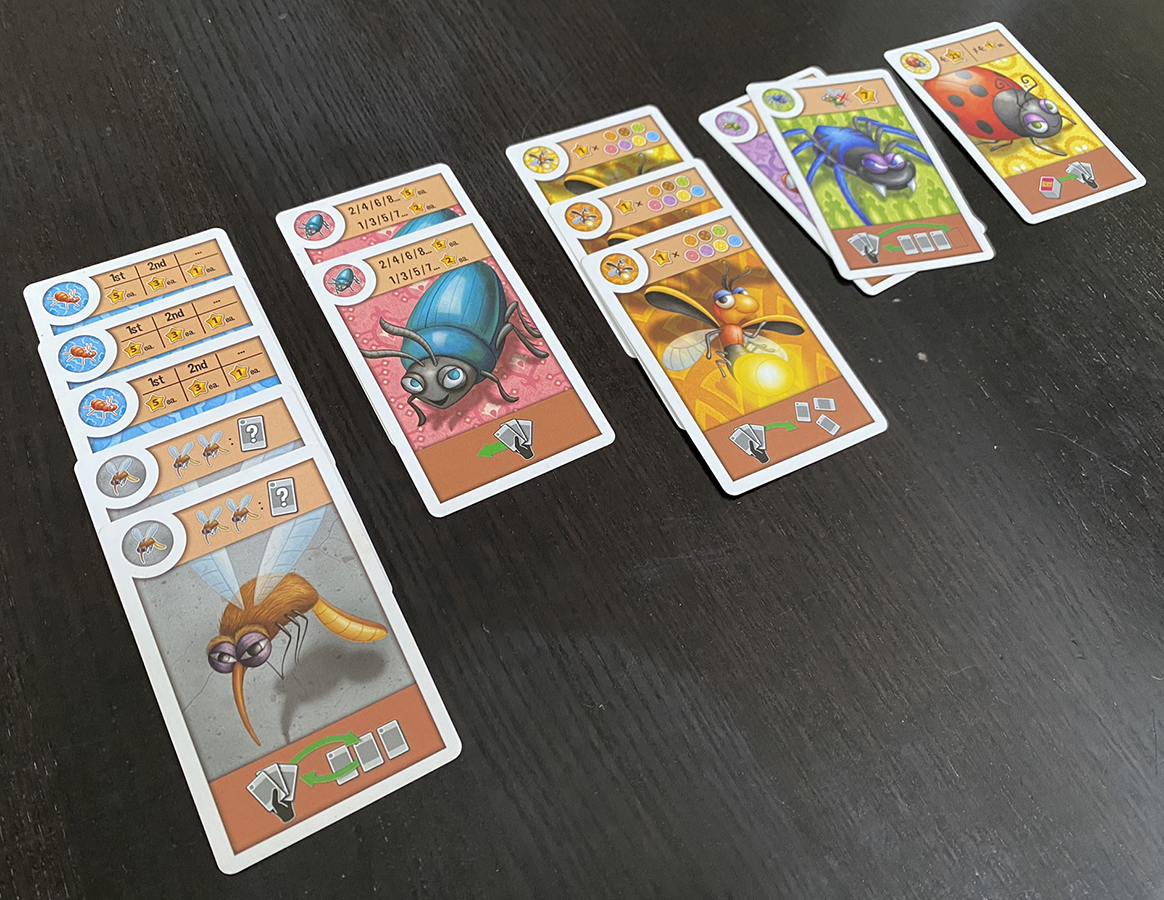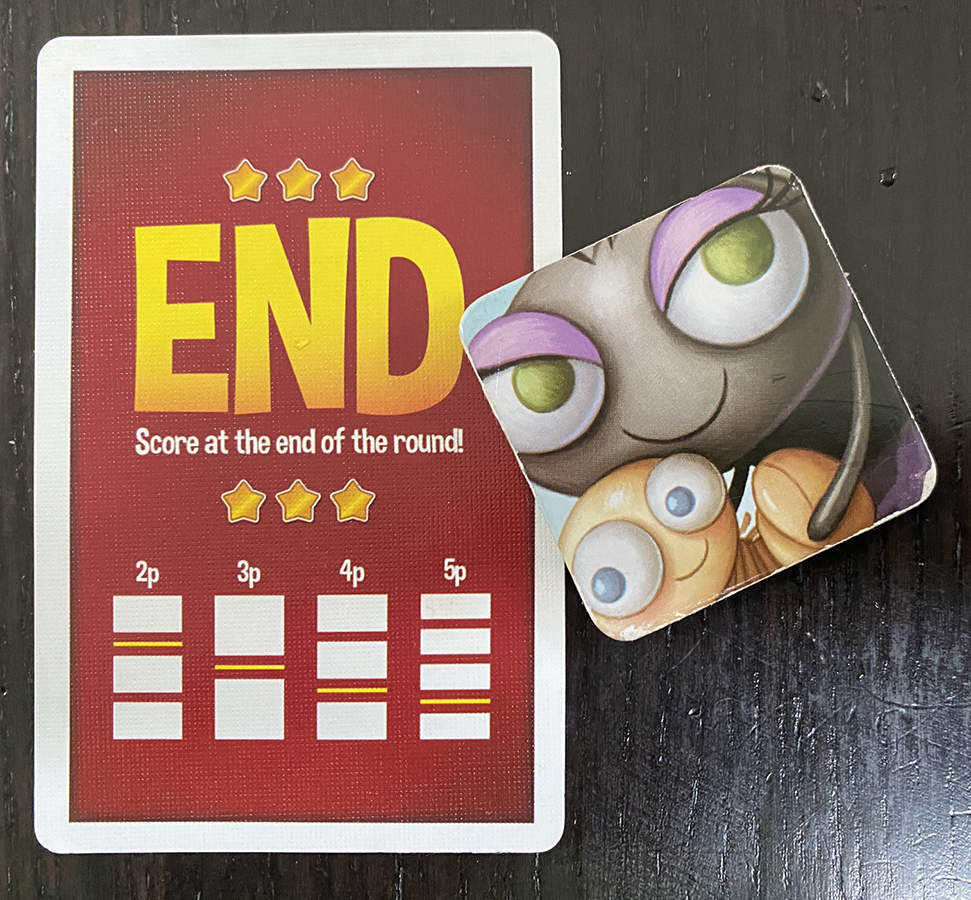Do you like bugs? Or perhaps you prefer rugs? How about bugs on rugs?
What Is Bugs on Rugs?
Bugs on Rugs is a family card game for 2-5 players, ages 8 and up, and takes about 20 minutes to play. It’s designed by Peter C. Hayward and published by Kids Table Board Games (KTBG), with illustrations by Shawna Tenney. You can purchase it directly from KTBG for $14.50, or check your local FLGS.
Bugs on Rugs Components
This small box game comes with:
- 1 Rulebook
- 90 Bug Cards (10 each of 9 different bugs)
- 1 End Card
- 1 Start Player Marker
- 1 Score Pad

How to Play Bugs on Rugs
You can download a copy of the rulebook here.
The Goal
The goal of the Bugs on Rugs is to have the most points at the end of the game. You do this by collecting sets of bugs, each with their own unique scoring pattern.
Setup
Setup is dependent upon the number of players. Shuffle the entire deck of Bug Cards and then insert the End Card into the deck as indicated based on the player count. Then deal each player 1 facedown Bug Card, flip the top card of the deck face up and place it next to the deck. This area is called “The Wall.” Lastly, select a starting player and give them the Start Player Marker.
Gameplay
On each turn, Bug Cards are dealt face-up into the middle of the table. The number of cards is equal to 2 per player + 1 additional card. Then, beginning with the starting player and going clockwise, each person will draft a single card. After the last player selects a card, repeat the process, but in reverse order. This process is known as a snake draft. When the drafting is complete, place the last card that’s leftover at the end of The Wall and activate its wall power (more on that below). Give the next person the Start Player Marker and repeat until the End Card is revealed.
Wall Powers
Each bug type has a different wall power that will be activated when placed on The Wall.
Butterfly: The starting player reveals any bug from their hand (except for a butterfly or larva) and activates that bug’s wall power.
Spider: In turn order, place a card from your hand to the end of The Wall, and then take the card at the beginning of The Wall.
Fly: Each player passes 1 card to the person on their right. Don’t look at the card you receive until you have passed one.
Ladybug: In player order, draw a card from the top of the deck and add it to your hand.
Larva: The first larva card on The Wall does nothing; however, when there are two larvae on The Wall, put both of them on the bottom of the deck and then add a new card to the end of The Wall from the top of the deck. Activate that card’s power.
Mosquito: In turn order, each player swaps a bug from their hand with a different bug on The Wall. You are not allowed to pick up the same type of bug that you placed.
Firefly: In turn order, place 1 bug from your hand, face-up into the middle of the table. These will be part of the draft pool for the next round.
Ant: Draw a card from the deck and add it to the end of The Wall. Activate its power.
Beetle: Each player passes 1 card to the person on their left. Don’t look at the card you receive until you have passed one.

Game End
The game ends once the End Card is revealed. When this happens, remove it from the game, continue revealing Bug Cards until you have the correct number showing, and finish that round. Afterwards, gather up your collection of insects and score them. The player with the most points is the victor. If there is a tie, the player who has the highest score for any single bug type is the winner.
Scoring
Similar to wall powers, each bug type scores differently.
Butterfly: Each butterfly scores 1 point for each bug type that you have exactly 1 of, including itself.
Spider: A spider scores 7 points if you feed (discard) a fly to it. Otherwise, it’s worth 0 points.
Fly: Flies are worth 2 points each. Or can be fed to a spider as noted above.
Ladybug: You will need exactly 4 ladybugs to score 25 points. Any other quantity scores only 1 point each.
Larva: Similar to the spider, the larvae are worth 0 points unless you feed (discard) a mosquito to them, making them 3 points instead.
Mosquito: These annoying insects are 0 points by themselves, but a pair of them can be used as any other bug type.
Firefly: Each of these bright bugs score 1 point per rug pattern in your collection. There are 7 different patterns so they are each worth a potential 7 points.
Ant: You will want an army of these crawlers to get the most points because they are worth 5 points each for the player with the most ants, 3 points each for the player with the second-most, and 1 point each for everyone else.
Beetle: Collect these bugs in pairs because they score 5 points each if you have an even amount, but only 2 points if the total is odd.

Why You Should Play Bugs on Rugs
I had originally bought Bugs on Rugs upon its release in 2019, and had played 1 game of it with my wife and eldest daughter at that time. Then it sat dormant on my game shelf until this past spring when I threw it in my game bag while backing for a trip. Little did I know that it would become the hit family game. As the publishers name implies, they develop kid friendly games, but their intention is that they are not strictly kid’s games. Their goal is for the game to have simple enough rules that kids can play, but enough depth and strategy to make it enjoyable for adults as well. Bugs on Rugs is no exception to those rules. But what makes is so accessible by both kids and adults?
Let’s start with the artwork. I have 3 girls and bugs are not typically well received in our household. A spider sends them yelling for me to come get it and a buzz in their ear makes them flee in terror in case it’s a bee. However, the artwork of Bugs on Rugs is so adorable that even the wormlike larvae makes you want to snuggle them. While my younger children tend to gravitate towards collecting the colorful butterflies, they will still gather up it’s more common cousin, the fly, when needed. The artwork makes the game immediately accessible by all ages.
Along those same lines, the graphic design is very well done. For the most part, Bugs on Rugs is language independent. Each card indicates on that bug type scores at the top of the card while the bottom displays it’s wall power. You wouldn’t understand all the symbology without reading the rulebook, but once you know what each critter does, then the graphic design is all you need as a reminder. Having the scoring and wall powers on every card means that you always know what you need to collect to maximize your points.
As I previously mentioned, this game became a family hit. While the box says ages 8 and up, my 5 year old was able to play with some assistance. She tends to focus on the bugs that she like best, but since Bugs on Rugs is a set collection game, that’s not a bad strategy. And because there is a bit of randomness that happens due to wall powers, it keeps her and everyone else competitive. At this point, my family has played this game a lot, and at all player counts. It plays well at 2 players as well as it does at 5 players. And regardless of age or skill level, everyone has a chance to win. I have even lost to my youngest child, which she continues to tell everyone at least once a week.
Who know that a small box filled with cute little bug cards would appeal so much to my family. When I packed Bugs on Rugs for that trip, my intention was to give it one my try before culling it. But I am thrilled that my family took to this game and it gives us a fun activity that all five of us enjoy! So if you are searching for that next family game, let me put a buzz in your ear and recommend Bugs on Rugs!

Click here to see all our tabletop game reviews.
![]() To subscribe to GeekDad’s tabletop gaming coverage, please copy this link and add it to your RSS reader.
To subscribe to GeekDad’s tabletop gaming coverage, please copy this link and add it to your RSS reader.





